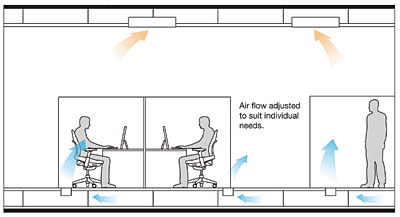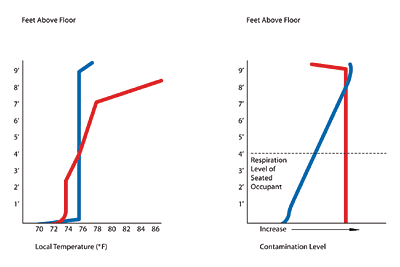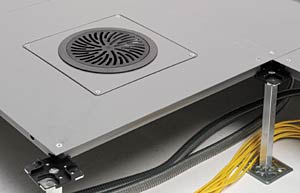Raised Access Floors: The Foundation of Flexibility and Efficiency
Underfloor Air Distribution (UFAD): Underfloor Air Distribution (UFAD) allows for a preferred method of air distribution to take place. Referred to as "displacement ventilation," this process locates air supply vents at the bottom of the occupied space and the return air vents at the top of the space. Hence, a UFAD system allows ducted supply air from the HVAC equipment to enter into the space between the access floor and the structural slab creating a continuous volume low-pressure plenum. From there, the conditioned air rises easily into the user's zone through diffusers located strategically in the floor. As the air moves through the room, it gains heat from users, computers, equipment, and lighting. It continues to move upward until it is exhausted out of the space through the return air plenum in the ceiling. This type of conditioned air distribution has been shown to provide the following benefits and advantages (Figure 3-Underfloor Air Distribution System):
|
- Improved air quality: With underfloor air distribution, there is an increase in the total amount of air flow and ventilation since room air and supply air are more thoroughly mixed and more complete air changes are possible. Thus, as the conditioned air rises up throughout a room, it collects more particles and pollutants pulling them away from the user directly into the return air system where pollutants can be removed or reduced. This reverses the tendency of overhead systems to push pollutants down towards the users in the space and creates lower levels of contaminants in the occupied spaces and rooms. Independent studies have documented these results. (Figure 4-Air Quality Comparison):
|
- Improved thermal comfort: In addition to improved air quality, underfloor air distribution can offer a more comfortable range of air temperatures. Because the air does not need to be pushed down to reach users in the space, as is the case in overhead distribution, the air temperature does not have to be heated or cooled as much. Hence, the plenum temperature can be adjusted to simply allow for the normal variations within occupied rooms and be set closer to typical desired levels. Therefore, the air temperature ranges are much smaller, allowing for greater thermal comfort. Further, by properly locating floor and ceiling diffusers, drafts and cold spots can be virtually eliminated.
- Temperature control: Providing adjustable floor diffusers that allow users to control the volume of air entering their space gives them the ability to determine their own individual comfort level. It has been generally acknowledged that greater worker productivity results when a user has the ability to control the air in their work space. This makes sense in light of the fact that the number one and number two complaints at work are "I am too cold" and "I am too hot." Occupants with no control are believed to be twice as sensitive to temperature changes while those with more control have fewer complaints. While more diffusers allow for more occupant control, they do not add to the total overall air flowing into the space; that is determined by the pressure within the plenum beneath the floor.
- Energy use:Underfloor air distribution has been tested and shown to reduce the amount of energy used for heating and cooling typical commercial and institutional spaces. First, less energy is needed to deliver the air through the underfloor plenum compared to overhead systems. Typically, HVAC system fans and motors can be reduced in size, since only .05 inches of static pressure is necessary to deliver air through an underfloor plenum. Additionally, overhead distribution systems require cooler temperatures, meaning bigger chillers and more energy use. (Figure 5- Less energy is used with underfloor air):
|












